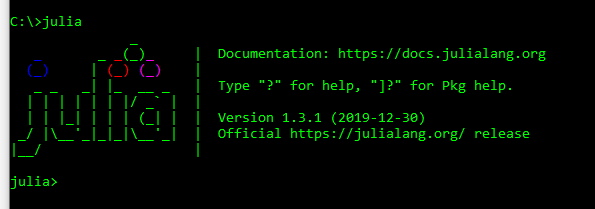Table of Contents
Installation
You can download the installer at https://julialang.org/
On Windows you have to set the path manually, e.g. C:\Julia-1.3.1\bin
Let’s fire up a command line and type: julia

You will be greeted with a nice little ascii art and the prompt.
If You want to close the prompt You can use CTRL + D
Hello Julia
To get over with, here is the hello world
julia> show("Hello Julia")
"Hello Julia"
Julia has a show function which gives you decorated text interpretations
But there is also a print function
julia> print("Hello Julia")
Hello Julia
Writing Programs
julia code is put into files with the file extension .jl
so let’s write the hello julia to a file
We can start it via
julia hello-julia.jl
Reading and Writing Files
open("data.txt") do file
for line in eachline(file)
println(line)
end
end
asdf
open("data.txt") do file
for line in enumerate(eachline(file))
println(line[1], ": ", line[2])
end
end
Reading CSV
As a developer with interest in data science I want to know what packages exist to handle data. The first one is the csv package to deal with comma separated values.
julia> import Pkg; Pkg.add("CSV")
julia>using CSV
julia>csv = CSV.read("./my_cars.csv")
5×4 DataFrames.DataFrame
│ Row │ Make │ Model │ Bought │ Sold │
│ │ String │ String │ Int64 │ Int64 │
├─────┼────────┼─────────┼─────────┼───────┤
│ 1 │ Fiat │ Punto │ 2005 │ 2009 │
│ 2 │ Ford │ Escort │ 2009 │ 2010 │
│ 3 │ Ford │ Fusion │ 2003 │ 2012 │
│ 4 │ Audi │ A5 │ 2012 │ 2099 │
│ 5 │ Honda │ Jazz │ 2015 │ 2099 │
Plots
import Pkg; Pkg.add("Plots")
using Plots
x = 1:10;
y = rand(10);
plot(x, y)






